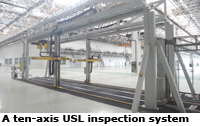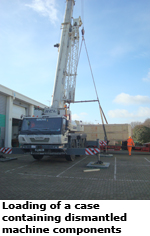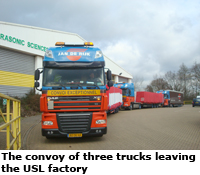Ultrasonic Sciences celebrates record year
01/03/2013
 Since the start of the recession, Ultrasonic Sciences Ltd (USL) has been bucking the trend for the manufacturing industry, seeing a continuous rise in order intake, turnover and profitability. The culmination is that 2012 was a record year, yet again. In November and December, a total of six large inspection systems and other major equipment was delivered to companies in the UK, the USA, China and The Netherlands.
Since the start of the recession, Ultrasonic Sciences Ltd (USL) has been bucking the trend for the manufacturing industry, seeing a continuous rise in order intake, turnover and profitability. The culmination is that 2012 was a record year, yet again. In November and December, a total of six large inspection systems and other major equipment was delivered to companies in the UK, the USA, China and The Netherlands.In the first few weeks of 2013, the installation and commissioning of these systems was nearing completion, whilst at the same time USL’s largest ever squirter inspection system was delivered to Japan. This machine, with a scan volume of 14 × 1.8 × 2.9 m, will be used by a manufacturer of aerospace composites for the inspection of parts being manufactured
 for Boeing and others. In common with other USL systems of this type (shown in the photograph), the system has ten scanning axes and a programmable fixture with a further five axes. Parts with a complex dual curvature can be scanned at speeds of up to 750 mm/s, using simultaneous through-transmission and pulse-echo methods, with water jets used for the transmission of ultrasound.
for Boeing and others. In common with other USL systems of this type (shown in the photograph), the system has ten scanning axes and a programmable fixture with a further five axes. Parts with a complex dual curvature can be scanned at speeds of up to 750 mm/s, using simultaneous through-transmission and pulse-echo methods, with water jets used for the transmission of ultrasound.Packing and shipping a system of this size poses some significant logistical problems. In this case, the consignment totalled 33 tonnes and required eight custom-made packing cases, three large articulated trucks and the same number of transport aircraft. The pictures show just one of the cases being loaded and the truck convoy leaving the USL factory.
A further four similar, although smaller, systems are currently under construction, together with several immersion testing units of various sizes.
 The ultrasonic inspection performance is the most important factor in selecting and designing equipment like this, but end users are becoming more demanding in how the machines are specified. In particular, the accuracy of mechanical construction and axis motion are often included in user specifications, in some cases with requirements measured in microns. This is not really necessary in industrial ultrasonic systems where the effective diameter of the sound beam is more than 1 mm, but nevertheless the accuracy has to be proven. To achieve this, USL has recently invested a near six figure sum in a Faro Laser Tracker. This can measure and record the position of a target to incredible accuracy in three dimensions. The results can be used to measure and adjust the flatness and squareness of machines during assembly, and then to compensate the motion axes to account for the inevitable small errors in the components of a drive system, such as rack and pinion or ballscrew units. This equipment will be used during the installation of large machines to ensure that the performance demonstrated during pre-delivery acceptance is maintained after final installation.
The ultrasonic inspection performance is the most important factor in selecting and designing equipment like this, but end users are becoming more demanding in how the machines are specified. In particular, the accuracy of mechanical construction and axis motion are often included in user specifications, in some cases with requirements measured in microns. This is not really necessary in industrial ultrasonic systems where the effective diameter of the sound beam is more than 1 mm, but nevertheless the accuracy has to be proven. To achieve this, USL has recently invested a near six figure sum in a Faro Laser Tracker. This can measure and record the position of a target to incredible accuracy in three dimensions. The results can be used to measure and adjust the flatness and squareness of machines during assembly, and then to compensate the motion axes to account for the inevitable small errors in the components of a drive system, such as rack and pinion or ballscrew units. This equipment will be used during the installation of large machines to ensure that the performance demonstrated during pre-delivery acceptance is maintained after final installation.www.ultrasonic-sciences.co.uk